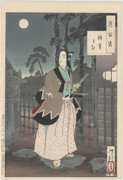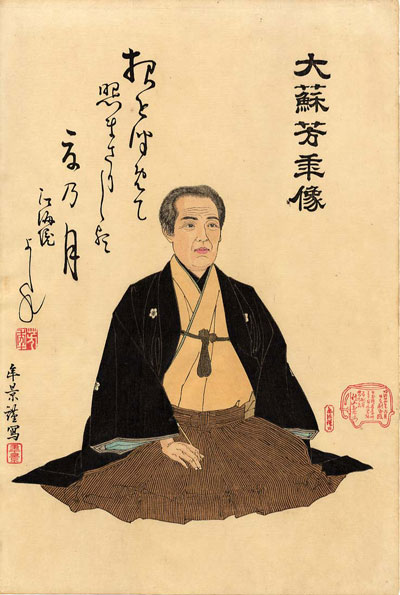Prints in Collection
By now you must be near Komakata, a cuckoo calls - Takao, 1885
IHL Cat. #970
IHL Cat. #54
IHL Cat. #1375
IHL Cat. #86 | IHL Cat. #87 | IHL Cat. #53 |
Takakura moon - Hasebe Nobutsura, 1886 IHL Cat. #333 | IHL Cat. #51 | IHL Cat. #88 | IHL Cat. #52 |
| Bon Festival Moon, 1887 IHL Cat. #1671 | Huai River moon - Wu Zixu, 1887 IHL Cat. #332 | IHL Cat. #43 | IHL Cat. #83 |
| Joganden Moon – Minamoto no Tsunemoto, 1888 IHL Cat. #39 | Taira no Tadanori, 1890 IHL Cat. #1670 | Kazan Temple Moon, 1890 IHL Cat. #113 | The Moon's Invention - Hozo Temple, 1891 IHL Cat. #80 |
One Hundred Aspects of the Moon (Tsuki hyakushi)
Source: Yoshitoshi's One Hundred Aspects of the Moon, John Stevenson, Hotei Publishing, , 2001, p. 53.
Likemost of his contemporaries, Yoshitoshi Tsukioka (1839-1892) was fascinated by the worldelsewhere, but as the decades passed he became increasingly concernedat how much his countrymen had lost by abandoning their traditions. Hetherefore took as subjects for his prints stories from Japan’s gloriousand colorful past. Though they looked backwards in the sense that theyillustrated historical events, Yoshitoshi’s prints were revolutionaryin their representation of individual human emotion and in theirpsychological sensitivity. The supreme example is his last greatseries of prints, Tsuki hyakushi, One Hundred Aspects of the Moon.
Tsukihyakushi is a series of one hundred single-sheet woodblock prints withthe moon as its unifying motif. It illustrates a wide range of figuresfrom Japanese and Chinese history, literature, and folklore. Apartfrom the moon or references to it (the moon is not always visible inthe print), the subjects are unrelated.
The first five designswere published in the autumn of 1885. New designs were issued singlyor in batches every few months, until the one hundredth was publishedshortly before Yoshitoshi’s death in the summer of 1892. The serieswas wildly popular even as it was being produced – people would line upbefore dawn on the morning of publication to buy a new design and stillfind the edition sold out. The Moon Series is often regarded today asYoshitoshi’s masterpiece.
Likemost of his contemporaries, Yoshitoshi Tsukioka (1839-1892) was fascinated by the worldelsewhere, but as the decades passed he became increasingly concernedat how much his countrymen had lost by abandoning their traditions. Hetherefore took as subjects for his prints stories from Japan’s gloriousand colorful past. Though they looked backwards in the sense that theyillustrated historical events, Yoshitoshi’s prints were revolutionaryin their representation of individual human emotion and in theirpsychological sensitivity. The supreme example is his last greatseries of prints, Tsuki hyakushi, One Hundred Aspects of the Moon.
Tsukihyakushi is a series of one hundred single-sheet woodblock prints withthe moon as its unifying motif. It illustrates a wide range of figuresfrom Japanese and Chinese history, literature, and folklore. Apartfrom the moon or references to it (the moon is not always visible inthe print), the subjects are unrelated.
The first five designswere published in the autumn of 1885. New designs were issued singlyor in batches every few months, until the one hundredth was publishedshortly before Yoshitoshi’s death in the summer of 1892. The serieswas wildly popular even as it was being produced – people would line upbefore dawn on the morning of publication to buy a new design and stillfind the edition sold out. The Moon Series is often regarded today asYoshitoshi’s masterpiece.
Akiyama Buemon's Albums of the Moon Series
The publisher, Akiyama Buemon, decided to preserve the blocks after each design was printed, allowing him to issue a bound album of the complete series, shorty after Yoshitoshi's death in June, 1892.1 The album was issued in an accordion-style binding with embossed covers, but it was often rebound by the buyers.2 A memorial portrait of Yoshitoshi by his oldest student, Toshikage, was included as a frontispiece to the albums.
Memorial portrait of Yoshitoshi
Kanaki Toshikage (fl. ca. 1890)
Kanaki Toshikage (fl. ca. 1890)
June Meiji 25 (1892)
Publisher's Advertisement
(appearing in the Yomiuri shinbun, 17 June 1892)
'One hundred aspects of the moon: the brush of Taiso Yoshitohi' (Tsuki kyakushi Taiso Yoshitoshi hitsu) ōnishiki-e: one hundred sheets; contents: two sheets: preface: one sheet; title page: one sheet for 104 sheets for the set for an actual price of 2 yen 50 sen. The prints, bound altogether in a beautifully made album with end leaves and silk damask (donsu) cover, costs an actual price of 4 yen; the album with cloth cover (kuzufu; cloth from kudzu fibre) is 3 yen 50 sen. Delivery costs near and far of both albums are handled by this shop.
The great ukiyo-e artist - the Master Tsukioka Yoshitoshi - devoted seven years to this One hundred aspects of the moon, and is one of the most exquisite works of his career. Depicting figures from Japan and China that are associated with the moon, these nishiki-e are matchless, and together with the scrupulous care by this publisher and in the carving, it is clear to all that these are not the type of undistinguished works that can be found anywhere today. The Master Yoshitoshi has regrettably passed on, but now an edition assembling the entire set is complete. The nishiki-e that exhibit the force of the Master's brush and embody his spirit are available only from this publisher - they are real views of one hundred true aspects of the moon, so we encourage you all the more to add them to your collection.
- Nihonbashi ward, Muromachi 3-chōme Kokkeidō
For additional details on the album go to Content Pages (IHL Cat. #78).
Refined Beauties as Models for the Series
Source: Kōgyo in His Own Words http://digital.library.pitt.edu/k/kogyo/kogyowords.html hosted by the Digital Research Library within the University Library System at the University of Pittsburgh.
Immense Popularity of Series
"We would like to inform the reader that Master Yoshitoshi's One Hundred Aspects of the Moon, ongoing since 1885 and published by Mr. Akiyama...is now finally complete. The achievement of such a great work by an artist in in fact a rare thing and is a signal accomplishment..." - The Yomiuri Shimbun, 22 May 1882.
Refined Beauties as Models for the Series
Source: Kōgyo in His Own Words http://digital.library.pitt.edu/k/kogyo/kogyowords.html hosted by the Digital Research Library within the University Library System at the University of Pittsburgh.
As related by Yoshitoshi's stepson, the artist Tsukioka Kōgyo (1869-1927), his stepfather "used the beauties who attended nō performances as his models" in Aspects of the Moon because they were "refined young woman of good families" rather than his previous "not refined" models who "came from the demimonde world."4
1 Yoshitoshi's One Hundred Aspects of the Moon, John Stevenson, Hotei Publishing, , 2001, p. 69.
2 Ehon: The Artist and the Book in Japan, Roger S. Keyes, The University of Washington Press with New York Public Library, December 2006, p. 240.
3 Ibid.
4 As quoted in Sakamaki Kōgyo, “Nō to nōga,” Bijutsu no Nihon, 6-1 (1914) 4-5.
Links
Website providing thumbnails and higher resolution images of entire series along with a brief description of each print's story:
http://yoshitoshi.verwoerd.info/
J. Noel Chiappa's website providing a complete set of thumbnails for the series:
http://mercury.lcs.mit.edu/~jnc/prints/100moon.html
The entire set of prints in album form is shown on the site of the New York Public Library Digital Gallery:
http://digitalgallery.nypl.org/nypldigital/dgkeysearchresult.cfm?keyword=yoshitoshi&submit.x=18&submit.y=9





















